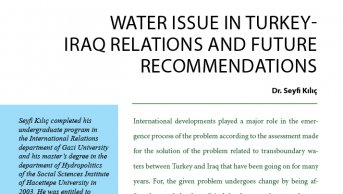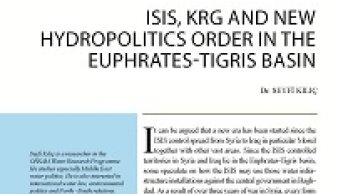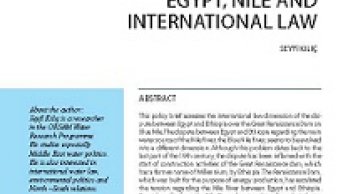Ignored Riparian in the Aral Sea Basin: Afghanistan

Two important rivers in the Aral Sea basin and the problems on transboundary water between the countries where those rivers flow into are one of the main focuses of the hydropolitics literature. Especially the fact that the amount of water reaching the Aral Sea, and that the Aral Sea came to the verge of destruction by shrinking as a result of this, increased environmental and economic concerns. As in every other field, the fact that the Soviet Union running against the United States of America also in the field of agricultural production diverted water from Amu-Darya and Syr-Darya in 1950s for irrigation purposes and started to irrigate large areas brought along environmental problems. As a result of shrinking of the Aral Sea, which is the most important environmental problem, the fact that clouds of saline dust rising from the lake bed prevailed in large areas, and also different problems such as salination of agricultural fields, rising of groundwater and problems related to water quality have been observed. The fact that waters accumulated in drainage canals constructed during the Soviet Union period were drained to rivers without any treatment is the main factor destroying the quality of water. In addition to this factor, residues of agricultural pesticides and fertilizers are among other factors leading to soil and water pollution.
Certain problems about utilization of waters emerged among the Central Asian republics which gained their independence following the collapse of the Soviet Union in 1991. Kazakhstan, Uzbekistan, Kyrgyzstan, Turkmenistan and Tajikistan, which are at different development levels and thus have different needs, engaged in activities to utilize river waters with different purposes. The management of basin waters which used to be dealt with a holistic approach during the Soviet period started to create problems among independent states. In the past, Kyrgyzstan and Tajikistan, which were upstream riparians of the rivers, used to keep water in dams during summer months for irrigation needs, and released water during months when there was need for water. In return, during winter months, downstream riparians sent natural gas and coal to Kyrgyzstan and Tajikistan, which kept water without generating power, and thus maximized mutual interests. However, this relationship between the aforesaid countries were ruptured following the independence of basin countries. Several agreements were signed throughout 1990s with the aim of doing similar adjustments among the basin countries as in the past period, but the aforesaid adjustments could not be put into practice due to the fact that each time different parties did not adhere to agreement.
First of all, in the agreements signed in 1992, the main subject ensured was to keep water during the months with high flow of water, and to release water during the irrigation season. In the agreements, among the liabilities of downstream riparians, it was also ensured for Kyrgyzstan to be paid for operation and maintenance cost during winter months. But as mentioned above, an efficient mechanism could not be established among parties despite the agreements.
As a result of irrigation that has been going on in Kazakhstan, Turkmenistan and Uzbekistan, which are downstream riparians, since the Soviet Union period, a certain amount of wealth was created. However, it appears that this wealth was created at the expense of upstream riparians. The deficiency on utilization of waters in upstream riparian countries is desired to be eliminated by those countries. The fact that Kyrgyzstan and Tajikistan which have lands in the Fergana valley, where political, ethnic and social tensions prevail, want to carry out activities to improve water resources present constitutes problem for downstream riparians. The fact that upstream riparian Kyrgyzstan and Tajikistan want to take advantage of those transboundary waters to generate hydro-electric power means less amount of water for downstream riparians during the irrigation season. Nevertheless, as hydro-electric power generation is not a water-consuming activity, it should be considered a problem that might be overcome through making an adjustment as during the Soviet period and beforehand in 1990s.
There is another important riparian which has not been paid attention to in Amu-Darya river so far. 17 billion cubic meters of river waters, of which annual average flow is 79 billion cubic meters, originate from Afghanistan. Some 1400 kilometers of the river road of 2400 kilometers flow through Afghanistan or set Afghanistan-Tajikistan border. 15% of the surface of Amu-Darya river basin, and 17% of the population is located within the borders of Afghanistan. On the other hand, it is limited for Afghanistan to utilize of river waters. Only 5 billion cubic meters of water is used for irrigation, and hydro-power electric is not generated. Afghanistan has plans that the hydro-electric power plants to be established on Kunduz and Kokcha rivers, which are tributaries of the Amu-Darya river which could meet the energy deficit of the country. It can be foreseen that Afghanistan's putting these plans into practice would decrease the quantity of water to be accessed by downstream riparians during the irrigation season. It should be taken into consideration that it would be possible only through adjustments to be made between Afghanistan and other countries of the basin.
There are various reasons lying behind the fact that Afghanistan has not been taken into consideration in Aral basin hydropolitics. During the Soviet Union period in 1958, an agreement was signed on border-setting waters with Afghanistan. This treaty and the other adjustments envisaged to negotiate and consult with other party before carrying out an activity to develop water resources. However, the collapse of the Soviet Union and changing political relations negatively affected the relations between Central Asian countries and Afghanistan. Due to tense relations with Taliban which seized power in Afghanistan and also due to the fact that Taliban government could not have a control all across Afghanistan, Afghanistan always opted out of the politics on Amu-Darya River. The fact that conflicts have not stopped after Taliban removed from the power following the U.S. invasion in 2001, and the lack of an efficient central government maintains this tendency. But, the document entitled “Transboundary Water Policy of Afghanistan” issued by Afghanistan in 2007 indicates that this situation will not further continue. In this document, certain accusations are made against downstream riparian countries. It is asserted in the document that downstream riparians took advantage of the unstable situation of Afghanistan it went through for the last three decades by increasing the amount of water they divert from transboundary waters, and that Afghanistan was deprived of the opportunity to develop and implement projects on these waters during that period. Still, it is underlined that Afghanistan will act in cooperation with the regional cooperation and that they will strive to draw foreign investors to the region.
The document mentioned above points out that there will be no change in the short term, but that Afghanistan is a riparian that should be taken into consideration in terms of the hydropolitics of the Aral Sea basin in the medium and long term. After that stage, it is obvious that the countries in the region will have to include Afghanistan as well in the arrangements they make.






